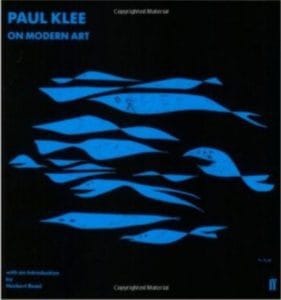 FROM THE VAULT | Paul Klee on Modern Art
FROM THE VAULT | Paul Klee on Modern Art
by Dr. Mark David Major, AICP, CNU-A, The Outlaw Urbanist contributor
Paul Klee on Modern Art (with Introduction by Herbert Read) is the text of a lecture delivered in 1924 at the opening of a museum exhibit of modern art (thus it reads in the first person). It is a series of brief commentaries on the Modernist creative process. Herbert Read’s brief but excellent introduction is an enlightening, concise summary of Klee’s intent in the lecture as well as the difficulties some readers might encounter while reading the text. Because Klee focuses on the creative process, he looks inward rather than outward (as he did in Creative Confessions), which gives the text a bit of an ego-centric viewpoint. In this sense, Modern Art is really about the artist in the world (in this case, Klee himself). Klee’s explicit reservations about speaking about his art also tends to make Modern Art feel somewhat defensive.
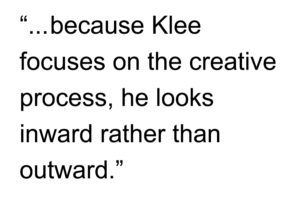 Because of this, Modern Art is not as rich with interesting observations, concepts and quotes that might find a common expression in architecture or urban planning (except perhaps its worst excesses, i.e. the architectural genius). Indeed, some of Klee’s text seems to pull back on his thoughts in Creative Confessions. For example, he states “line is the most limited”, which seems to contradict the ‘inherent energy’ he discussed in the other work. Instead, he shifts his focus to tone and color as an unmeasurable ‘quality’ in art, with explicit references to ‘mood’ in the artist and the emotions provoke in the character of a piece of art. In this sense, Modern Art represents a counter (and lesser) movement to Creative Confessions, of more limited application outside the realm of the artistic compulsion itself where there is “more value on the powers (i.e. the artist) which do the forming than the final forms themselves” residing “in the womb of nature” where the artist literally becomes a God himself in a creative act of genesis.
Because of this, Modern Art is not as rich with interesting observations, concepts and quotes that might find a common expression in architecture or urban planning (except perhaps its worst excesses, i.e. the architectural genius). Indeed, some of Klee’s text seems to pull back on his thoughts in Creative Confessions. For example, he states “line is the most limited”, which seems to contradict the ‘inherent energy’ he discussed in the other work. Instead, he shifts his focus to tone and color as an unmeasurable ‘quality’ in art, with explicit references to ‘mood’ in the artist and the emotions provoke in the character of a piece of art. In this sense, Modern Art represents a counter (and lesser) movement to Creative Confessions, of more limited application outside the realm of the artistic compulsion itself where there is “more value on the powers (i.e. the artist) which do the forming than the final forms themselves” residing “in the womb of nature” where the artist literally becomes a God himself in a creative act of genesis.
 Paul Klee on Modern Art
Paul Klee on Modern Art
by Paul Klee (with Introduction by Herbert Read)
55 pages
Faber and Faber Ltd. London. Paper Covered Editions (1967)
You can purchase Paul Klee on Modern Art from Amazon here.
Check out the Artsy.net Paul Klee page here.
From the Vault is a series from the Outlaw Urbanist in which we review art, architectural and urban design texts, with an emphasis on the obscure and forgotten, found in second-hand bookstores.

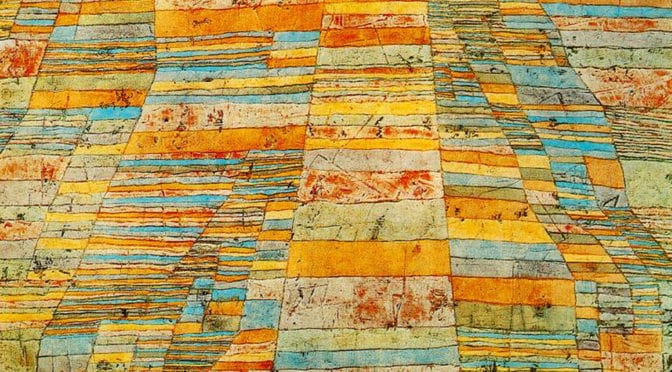
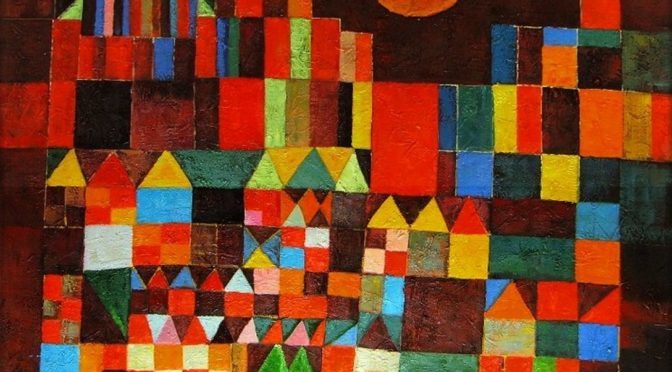
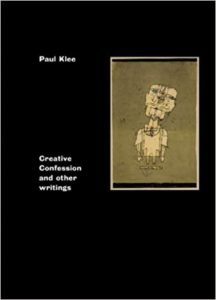
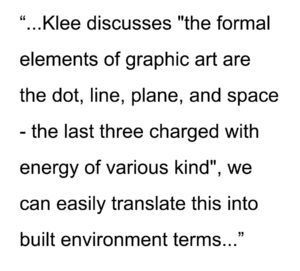 (dot=location, line=axis of movement, plane=convex space, and space itself is self-explanatory). Klee means this in terms of the energy of artistic gesture but we can also easily understand how these things in an urban environment are similarly ‘charged with energy’ in terms of movement, avoidance, and encounter.
(dot=location, line=axis of movement, plane=convex space, and space itself is self-explanatory). Klee means this in terms of the energy of artistic gesture but we can also easily understand how these things in an urban environment are similarly ‘charged with energy’ in terms of movement, avoidance, and encounter.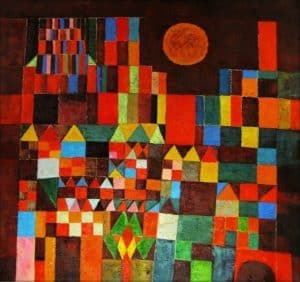
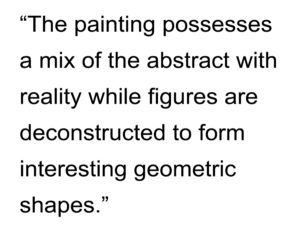 The clay colored background gives a clearer sense of how the shapes seem to form a city skyline of intense color and light. Klee uses pops of yellow to bring the eye in and break up the browns everywhere else. This oil on canvas painting has a complex array of triangular figures to provide an imaginary metropolis of shapes. The touch of realism, angles, and its use of color creates a city of geometric shapes. Paul Klee’s imaginary works continue to inspire and intrigue (Source: Totally History). Klee’s Castle and Sun, in particular, is regularly used by teachers for early education in artistic technique. At that age, school children (and perhaps their teachers) are unaware of the subtly complicated and innovative beauty of this painting by Klee.
The clay colored background gives a clearer sense of how the shapes seem to form a city skyline of intense color and light. Klee uses pops of yellow to bring the eye in and break up the browns everywhere else. This oil on canvas painting has a complex array of triangular figures to provide an imaginary metropolis of shapes. The touch of realism, angles, and its use of color creates a city of geometric shapes. Paul Klee’s imaginary works continue to inspire and intrigue (Source: Totally History). Klee’s Castle and Sun, in particular, is regularly used by teachers for early education in artistic technique. At that age, school children (and perhaps their teachers) are unaware of the subtly complicated and innovative beauty of this painting by Klee.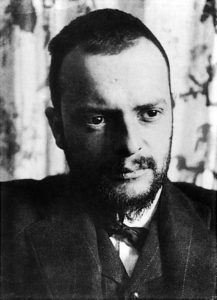 About Paul Klee
About Paul Klee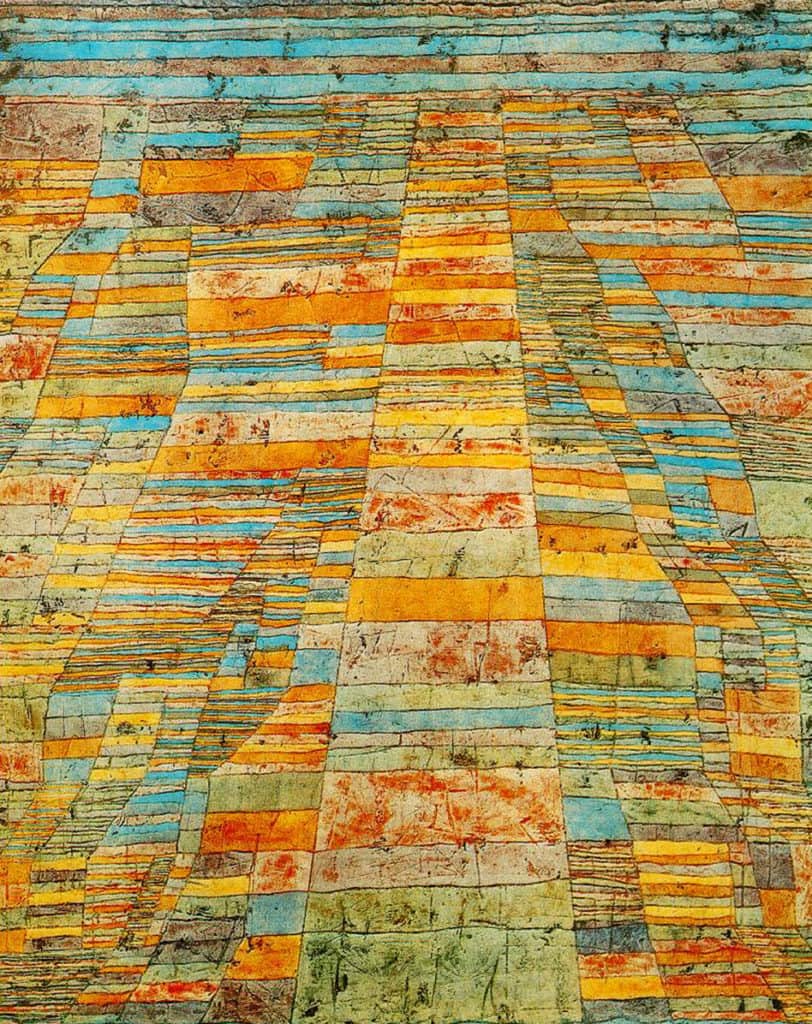
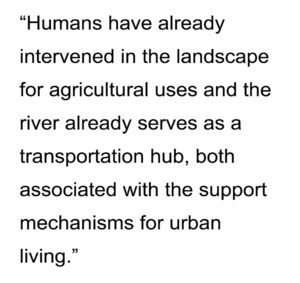 Perhaps skewed by an American perspective towards the land, it might suggest terre potentiel (the potential of the land). Humans have already intervened in the landscape for agricultural uses and the river already serves as a transportation hub, both associated with the support mechanisms for urban living. “In this pattern of fields, all is order, timeless structure, with a poetic element added… in twentieth-century creative language” (Source: PaulKlee.net). It is in this ‘timeless structure of order’ that can be found the design traces of a future urban pattern, a future city that has yet to emerge from the land but the potential for its emergence is already etched in the landscape. I love this painting, not so much for what it represents in the ‘here and now’ (though it is beautiful only on these terms) but what it represents about the possible, the “undiscovered country,” …the future, where all travelers must venture but none may journey before it is time.
Perhaps skewed by an American perspective towards the land, it might suggest terre potentiel (the potential of the land). Humans have already intervened in the landscape for agricultural uses and the river already serves as a transportation hub, both associated with the support mechanisms for urban living. “In this pattern of fields, all is order, timeless structure, with a poetic element added… in twentieth-century creative language” (Source: PaulKlee.net). It is in this ‘timeless structure of order’ that can be found the design traces of a future urban pattern, a future city that has yet to emerge from the land but the potential for its emergence is already etched in the landscape. I love this painting, not so much for what it represents in the ‘here and now’ (though it is beautiful only on these terms) but what it represents about the possible, the “undiscovered country,” …the future, where all travelers must venture but none may journey before it is time.